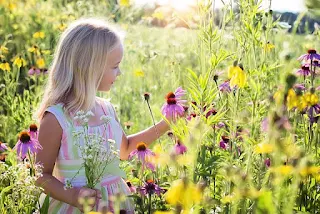Transforming your yard into an eco-friendly oasis is not just a home improvement project; it’s an educational opportunity for the younger members of your household. Engaging kids in no lawn landscaping can cultivate their love for nature, teach them the importance of sustainability, and help them develop essential life skills. Here are some fun and interactive ways to get them involved:
Personal Planting Patches
Giving a child their very own patch of garden is like handing them a blank canvas. Here's why this little patch is a big deal. I would've loved to have these as a child!
Sense of Ownership: Kids cherish what's theirs. As they see their plants sprout and bloom, the pride in their eyes is undeniable.
Local Plant Love: Picking drought-resistant or native plants introduces them to their region's unique flora. It's a hands-on geography lesson!
Cultivating Responsibility: Plants require care. Through watering and tending, kids learn patience and accountability.
Bonding with Nature: In a world of screens, this patch pulls them outdoors, helping them connect with the earth and its rhythms.
Lasting Memories: This isn’t just gardening; it's memory-making. The thrill of their first bloom will stick with them forever.
Veggie Venture
Have them plant their own vegetable garden. From sowing seeds to harvesting produce, the process teaches patience, care, and gives them a sense of accomplishment (plus, they might be more inclined to eat veggies they've grown themselves).
Wildlife Watchtower
Ever thought about turning that corner of your yard into a kiddo's nature nook? Here's why it's a brilliant idea:
Sprouting Artists: Planting wildflowers isn’t just about the blooms. Watch your kids' eyes light up as bees and butterflies drop by. It’s like nature's way of saying ‘thanks’ with a little dance.
Feathered Friends: Throw in a bird feeder, and boom! You've got a parade of chirpy visitors. Trust me, kids will be racing to call out, "Look, it's Mr. Robin again!"
Unexpected Guests: Sure, we're here for the birds and bees, but don't be surprised if a curious squirrel or a shy hedgehog decides to pop in. It's nature's version of a surprise party.
Diary of a Young Naturalist: Hand them a notebook. Whether they’re doodling a bumblebee or jotting down the antics of a blue jay, it's their personal slice of David Attenborough’s world.
Little Environmentalists: This isn’t just fun and games. As they get to know their garden buddies, they’re also soaking in lessons about how everything in nature is connected.
Turning a patch into a Wildlife Watchtower? It's not just gardening—it's crafting memories, sparking wonder, and maybe, just maybe, setting the stage for the next big nature lover. How cool is that?
Eco Art Studio
Ever picked up a leaf and seen a canvas? Or maybe looked at twigs and envisioned a masterpiece? Here's why turning your backyard finds into an artsy playground is pure genius:
Leafy Legacies: Leaves aren't just for crunching underfoot. Let the kids dip them in paint and stamp away. The result? Nature’s fingerprint in a splash of color.
Twiggy Tales: Sticks and twigs can be so much more! With a bit of imagination, they transform into rustic sculptures, fairy wands, or even miniature forts. Your backyard's the supply store, and imagination's the limit.
Floral Paintbrushes: Ditch the store-bought brushes. Blooms and petals can become the quirkiest, prettiest paint applicators. Dip, dab, and discover patterns nature's been hiding from us!
Natural Mosaics: Got pebbles and leaves? Arrange them into mosaics or patterns. It’s like putting together nature's puzzle, only you decide where each piece goes.
Eco Awareness with Art: As they craft, kids also imbibe a lesson in recycling and reusing. Nature’s giving us art supplies, and in return, we're showing a little love and creativity without waste.
Roll out the art mat, and let nature be the guide. With the Eco Art Studio, every leaf becomes a story, every twig a sculpture, and every bloom a brushstroke. And remember, it's not just about the end art piece; it's about the journey, the exploration, and seeing Mother Nature in a whole new hue. Happy crafting!
Compost Commanders
Ever thought of turning kitchen leftovers into a treasure trove for the garden? Here's why turning your little ones into compost aficionados is a stroke of genius:
Kitchen Magic: Those banana peels and apple cores? They aren’t trash, they’re compost gold! Watch the kids' excitement as they turn kitchen 'waste' into garden wonder.
Leafy Layers: Fallen leaves in the yard? To the compost bin they go! The kids will soon learn it’s not just litter but a layer in the compost cake they're baking.
Green Cuts: Grass clippings might look like garden haircuts, but in the hands of our Compost Commanders, they become the green fuel that supercharges the compost mix.
Transformation Time-lapse: It's like nature's cooking show. Over weeks, they'll witness the transformation from scraps to rich, crumbly compost. It’s like magic, only slower and muddier!
Earth Science 101: This isn’t just muck and mire. Through composting, kids absorb lessons about decomposition, recycling, and the circle of life in our ecosystem.
Hand them a shovel, and dub them the Compost Commanders. It's not just about reducing waste; it’s about crafting life lessons, igniting curiosity, and fostering a bond with the earth. Before you know it, they'll be the neighborhood's go-to gurus on turning scraps into garden gold! How rad is that?
Involving kids in no lawn landscaping not only makes the process more enjoyable but also instills in them an appreciation for nature and the environment. Remember, the goal isn't just to create a beautiful yard but also to nurture the next generation of eco-conscious individuals. Happy gardening!










